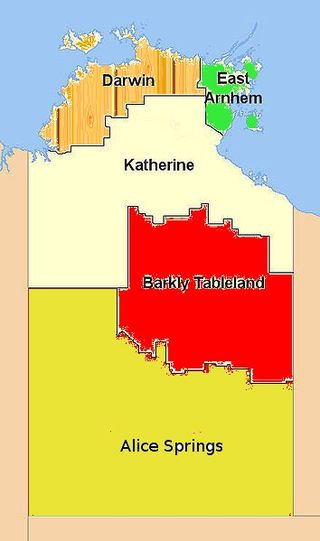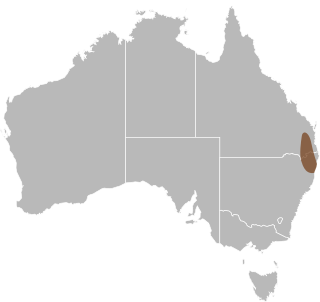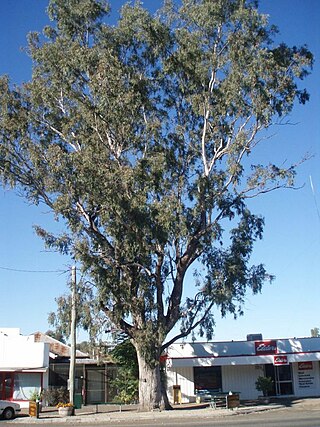
The Top End of Australia's Northern Territory is a geographical region encompassing the northernmost section of the Northern Territory, which aside from the Cape York Peninsula is the northernmost part of the Australian continent. It covers a rather vaguely defined area of about 245,000 km² behind the northern coast from the Northern Territory capital of Darwin across to Arnhem Land with the Indian Ocean on the west, the Arafura Sea to the north, and the Gulf of Carpentaria to the east, and with the almost waterless semi-arid interior of Australia to the south, beyond the huge Kakadu National Park.

Acanthophis is a genus of elapid snakes. Commonly called death adders, they are native to Australia, New Guinea and nearby islands, and are among the most venomous snakes in the world. Despite their common name, they are not adders at all and belong to the Elapidae family. The name of the genus derives from the Ancient Greek akanthos/ἄκανθος ('spine') and ophis/ὄφις ('snake'), referring to the spine on the death adder's tail.

The Barkly Tableland is a rolling plain of grassland in Australia. It runs from the eastern part of the Northern Territory into western Queensland. It is one of the five regions in the Northern Territory and covers 283,648 square kilometres (109,517 sq mi), 21% of the Northern Territory. The Barkly Tableland runs parallel to the southern shore of the Gulf of Carpentaria, from about Mount Isa, Queensland to near Daly Waters.

The mud adder, also known commonly as De Vis' banded snake or Devis's banded snake, is a species of venomous snake in the family Elapidae. The species is endemic to certain regions of eastern Australia, including South West Queensland, northern New South Wales, north-west Victoria, and South Australia. Its scientific and common names refer to Charles Walter De Vis.

The common death adder is a species of death adder native to Australia. It is one of the most venomous land snakes in Australia and globally. While it remains widespread, it is facing increased threat from the ongoing Australian cane toad invasion.

The desert death adder is a species of snake native to Australia and is one of the most venomous land snakes in the world. The desert death adder is under threat due to the destruction of habitat.

The yellow-bellied glider, also known as the fluffy glider, is an arboreal and nocturnal gliding possum that lives in native eucalypt forests in eastern Australia, from northern Queensland south to Victoria.

The collared delma or adorned delma is the smallest species of lizard in the Pygopodidae family endemic to Australia. Pygopopdids are legless lizards, so are commonly mistaken for snakes. They are distributed mainly across south-east Queensland and northern New South Wales, in both forests and some suburban areas. They are active during the day, seen foraging and hunting for small insects.

Echiopsis curta is a terrestrial, elapid species of snake, also commonly known from the Aboriginal name as the bardick. It is a short, highly venomous snake with variable color which is mainly nocturnal, reaching a maximum length of 57 cm. It is endemic to Australia, most commonly found in three distinct populations through southern Australia. They are considered venomous to humans, however there is very little information. Their population is decreasing due to habitat degradation and destruction but considered least concern on the IUCN Red List.

Spencer's goanna, also known commonly as Spencer's monitor, is a species of monitor lizard in the family Varanidae. The species is endemic to Australia.

Eucalyptus microtheca, commonly known as the coolibah, is a species of tree that is endemic to northern Australia. It has rough, flaky or fibrous bark on the trunk and branches, lance-shaped adult leaves, flower buds in groups of seven, white flowers and spherical to conical fruit. It is widely distributed from the Kimberley region of Western Australia to Cape York in Queensland.

The Hawkei is an Australian light four-wheel-drive protected mobility vehicle. Originally designed in 2010 to meet an Australian Defence Force (ADF) requirement for a light armoured patrol vehicle to replace some of its Land Rover Perentie variants. The Hawkei is a highly mobile, highly protected, 7-tonne vehicle, with inbuilt systems to allow it to be used as a fighting platform. It has been developed with Vehicle Electronic Architecture to be mission system ready. It is intended to undertake a range of mission profiles, including troop movement, command and control, electronic warfare, liaison, surveillance and reconnaissance. Prime contractors include: Thales Australia, Boeing Australia, Plasan (Israel) and PAC Group. In October 2015, the Australian Government announced the purchase of 1,100 Hawkei vehicles from Thales Australia.

Cryptoblepharus australis, commonly called the inland snake-eyed skink, is a species of skink in the genus Cryptoblepharus.
The Queanbeyan Nature Reserve is a protected nature reserve that is located in the Southern Tablelands region of New South Wales, in eastern Australia. The 67-hectare (170-acre) reserve is situated approximately 4 kilometres (2.5 mi) west-south-west of the City of Queanbeyan.

The Gregory River is a river in the Northern Territory and the state of Queensland, Australia. The river is the largest perennial river in arid and semi-arid Queensland, one of the few permanently flowing rivers in the northwest of Queensland.

Persoonia terminalis, also known as the Torrington geebung, is a shrub belonging to the family Proteaceae, and native to northern New South Wales and southern Queensland in eastern Australia. Reported as a subspecies of Persoonia nutans in 1981, it was described as a species by Lawrie Johnson and his colleague Peter Weston in 1991.

The northern death adder is a species of venomous snake in the family Elapidae.
The rough-scaled death adder is a species of venomous snake in the family Elapidae.
The Kimberley death adder is a species of venomous snake in the family Elapidae native to northwestern Australia.
The Pilbara death adder, also known commonly as Wells' death adder, is a species of venomous snake in the family Elapidae. The species is one of the eight members of the genus Acanthophis, a genus which is found throughout northwestern and southwestern Australia and some parts of southern Papua New Guinea. The species Acanthophis wellsi is endemic to Western Australia.
















